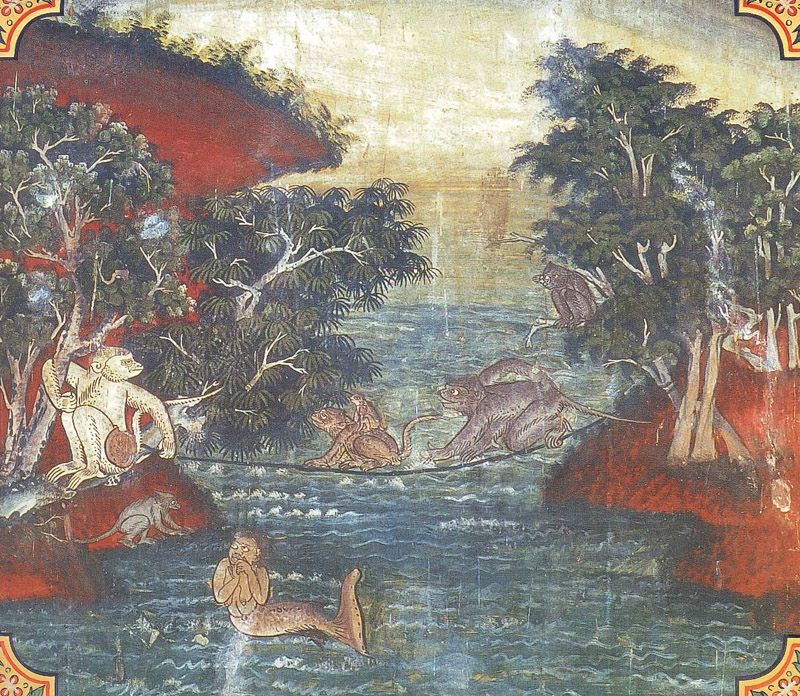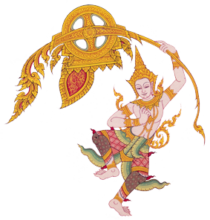
The Bodhisatta was once a king of monkeys. He led a troop of eighty thousand that fed regularly in a giant mango tree on the bank of the Ganges River that bore the sweetest, most delicious fruit. Not wanting anyone to ever discover this divine tree, the monkeys picked all the flowers that grew in branches over the water so that no fruit could fall in and float away. Despite this caution, one fruit, hidden by an ant’s nest, grew ripe and dropped into the river. It floated far downstream and got caught in a fisherman’s net. He showed the massive fruit to the king, who showed it to his foresters, who assured him it really was a mango. He tasted it, and the flavor stirred his entire body. Wanting more, he had the foresters lead him upstream into the Himalayas to find the tree. When they reached it, the king and his entourage filled themselves with the fruit and set up camp underneath its branches.
At midnight the Bodhisatta and his troop arrived and started to feed. When the king woke and saw the monkeys eating the fruit, he ordered his archers to surround the tree and prepare to kill all of them in the morning. With his outstanding strength, the Bodhisatta jumped over the river and joined two vines together that would reach the mango tree. He tied one end to a tree and the other to himself and jumped back. But he forgot to account for the part of the rope around his waist and came up just a bit short. He grabbed a branch firmly with both hands and told the monkeys to walk over his back to escape. The last monkey to cross despised the Bodhisatta and climbed up high before jumping hard on the Bodhisatta’s back, breaking it.
The king watched all this happen and was moved by the Bodhisatta’s selfless rescue, so he brought him down and tried to save him. The king asked the Bodhisatta why he did it, and with his dying breaths he answered that a truly good leader must care for his subjects to no end; their happiness and safety is his only goal.
The king ordered that the Bodhisatta receive a funeral fit for a king with a pyre made from one hundred wagonloads of timber, and then had his skull decorated with gold and placed in a relic shrine. Following the Bodhisatta’s lesson, the king lived out his days in righteousness, giving alms and doing other good deeds.
In the Lifetime of the Buddha
King Pasenadi, a righteous ruler and devoted supporter of the Buddha, always provided food for the Buddha’s disciples, but they did not stay and eat at the palace because the people there were not friendly. When the king found out that they went to eat at their friends’ homes, he decided to marry a woman from the Buddha’s Sakya clan in order to build closer relations with the Buddha and his disciples. However, the Sakya clan was arrogant and insular and did not want to marry into a relationship with the king; but because he was their leader, a request like this could not be refused without consequences. So they sent a daughter of a nobleman born to a slave woman and told King Pasenadi she was noble.
Knowing the Sakya clan’s reputation, the king’s assistants wanted to be sure the woman they were taking back was truly noble-born. So the family faked eating a meal together as proof. This was done by having what was claimed to be a very important letter delivered to the father at the start of the meal, so after taking just one bite he sat at the table reading rather than eating. This made it appear that he had dined with his daughter, but since he didn’t actually eat, he didn’t degrade himself with a slave.
King Pasenadi truly loved his new consort and made her his chief queen. Soon a son was born and he grew up receiving all the advantages a prince deserved, except he did not get gifts from his maternal grandfather’s family. Not wanting her son to know about her life, his mother lied and told him they sent nothing because they lived very far away. Once he grew up, he decided to visit his other family; and though she tried, his mother could not stop him.
Upon learning the prince was coming, the Sakya clan sent all their noble children younger than him away to the countryside so nobody would need to bow down in respect to someone born from a slave. A few days later, when the prince was leaving, one of his soldiers overheard a Sakya slave saying the prince’s mother had been a slave. Now knowing how the Sakyas had disrespected both his mother and him, the prince vowed to destroy them when he became king.
When King Pasenadi heard the news about his wife, he was furious and gave her and his son nothing more than he gave to his other slaves. But a few days later, the Buddha, while admitting that his clan did wrong, explained to the king that his queen and son were children of royal men and the mother’s birth was irrelevant. The king changed his mind and restored their honor.
The wife of King Pasenadi’s commander-in-chief had never borne him a son, so he sent her back to her family. Accepting her fate, she went to pay respect to the Buddha before departing, and he told her not to go. Elated by his counsel, she went home and told her husband. The commander-in-chief figured the Buddha must have a good reason for it and let her stay. Soon after, she got pregnant. She told her husband she wanted to bathe in and drink the holy water used for ceremonial sprinkling by the families of kings from another clan, so he took her to the well in his chariot.
Once there, the commander-in-chief fought off the guards and broke through the iron net, and they both bathed in the holy water before fleeing the city. Furious about this egregious violation, five hundred kings ignored the warning from their spiritual advisor that the commander-in-chief would slay them all and chased after him in their chariots. The commander-in-chief waited for all five hundred chariots to line up just right; then he shot an arrow with his special bow, one thousand times stronger than a regular bow, and it passed through all five hundred kings right at the point where they fastened their belts. The kings did not notice their injuries and continued pursuit until the commander-in-chief stopped his chariot and shouted at them that they were already dead. Still standing and feeling fine, the kings thought he was crazy. But he told them to loosen one man’s belt, and upon doing so the man fell over dead. The commander-in-chief told the other men to go home and set their affairs in order before taking off their armor, and they all did, dying when they were ready.
Over time, the commander-in-chief’s wife gave birth to twin boys sixteen times. All thirty-two of their sons grew up to be heroic and perfect in every way.
One day some men who lost a court case pleaded with the commander-in-chief to help them because they felt that the judges were corrupt. He looked into the matter and found that the judges really were corrupt, so he judged the men’s case himself and sided with them. The city’s citizens applauded his intervention, and when King Pasenadi learned about it, he put the commander-in-chief in charge of the court system. But the judges lost so much money by not being able to take bribes that they told the king his commander-in-chief was planning to overthrow him. Believing this lie, the king decided he must kill him. He hired some men to pillage towns in a border region and sent his commander-in-chief and all thirty-two of his sons to capture these bandits. King Pasenadi also ordered some of his soldiers to behead the commander-in-chief and his sons while they were away; and they did.
When she learned of her husband and sons’ executions, the commander-in-chief’s wise wife summoned all thirty-two daughters-in-law and told them not to be angry or upset. Though their husbands were pure and innocent now, this must have resulted from misdeeds in their former lives. Seeking revenge would be a sin even worse than the king’s. King Pasenadi’s spies reported this meeting to him, and after hearing about their reaction he was overcome with remorse. The king went to see the Buddha, and while he was away from the palace, his new commander-in-chief, angry about the assassination, pulled a coup and put the half-slave prince on the throne. King Pasenadi vowed to reclaim his kingship and set out for his city, hoping to muster some troops. He arrived after the gates had been closed for the evening and had to spend the night in a shed. Weak from traveling far and fast in the sun and wind, he died of exposure that night.
The new king had never forgotten his grudge against the Sakya clan for their disrespect, and now he could finally get revenge. He set out with a large army to their territory. The Buddha divined what was happening and wanted to save his clan. He went to the border and sat under a small tree that provided little shade. When the king came to this area, he stopped to greet the Buddha and asked why he didn’t sit under the large, shady banyan tree nearby. The Buddha answered that the shade of his family kept him cool. The king understood this meant the Buddha was there to protect his clan, so he turned around. The king later set out on the warpath twice more, and both times the Buddha sat under the same tree, causing the king to back down.
After stopping the king’s rampage for the third time, the Buddha heard some of his disciples talking about how great he was for protecting his clan. He told them this story so they knew that he had also done good things for his family in the past.
Later, the king set out a fourth time hoping to destroy the Sakya clan. This time the Buddha decided that because of his clan’s sins, he would not protect them anymore. The king’s army slayed everyone they met, starting with babies, then returned to the palace.
The evil monkey was an earlier birth of Devadatta, a disciple of the Buddha who became his nemesis and tried to kill him three times. The king was an earlier birth of Ananda, one of the Buddha’s top disciples, and the Bodhisatta’s troop of monkeys were earlier births of the Buddha’s loyal followers.
